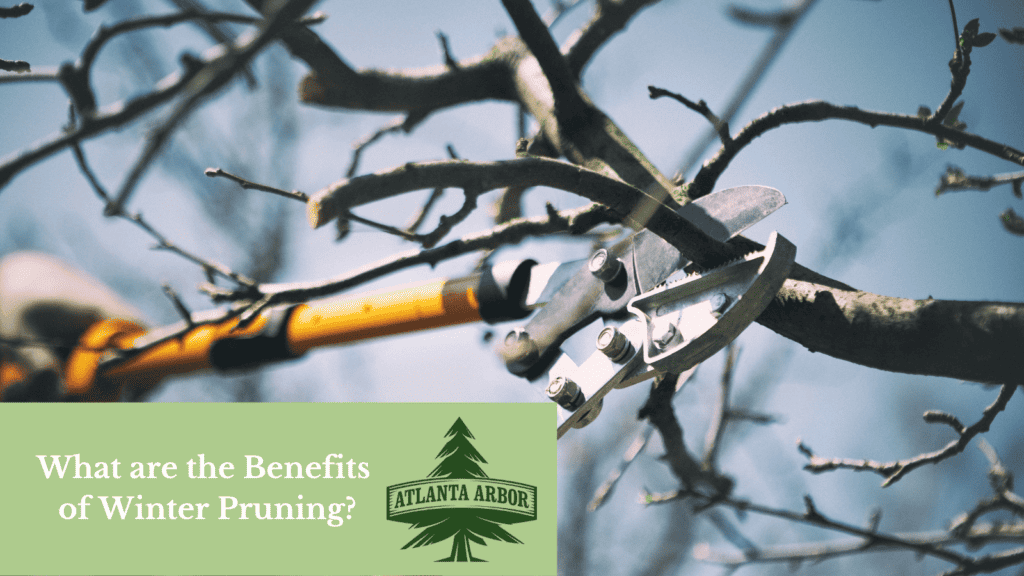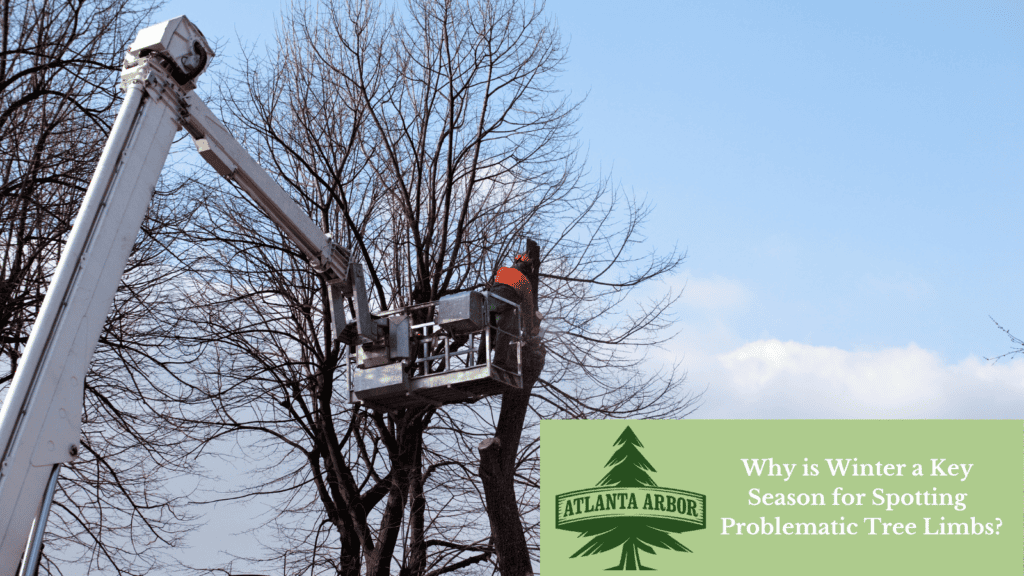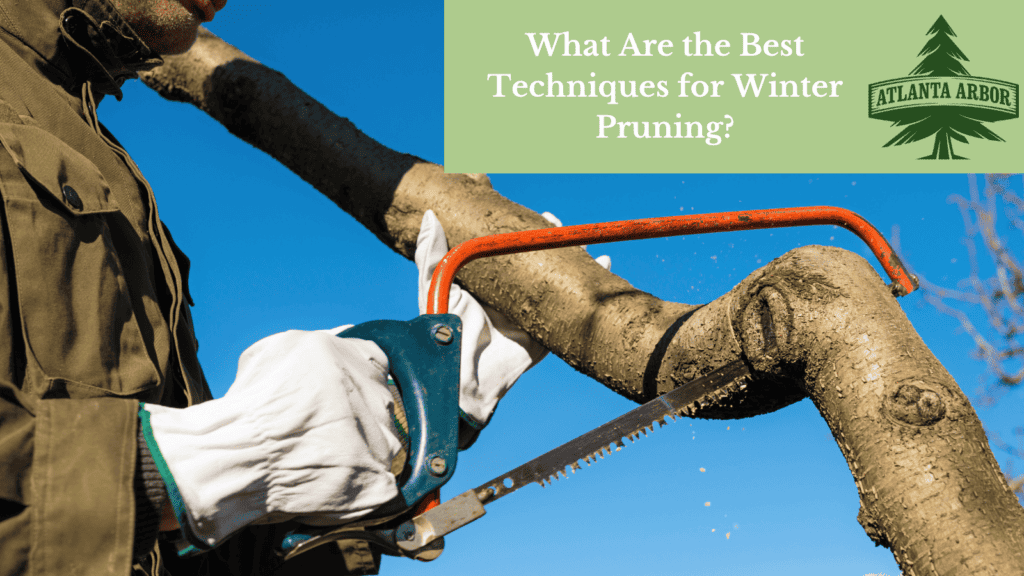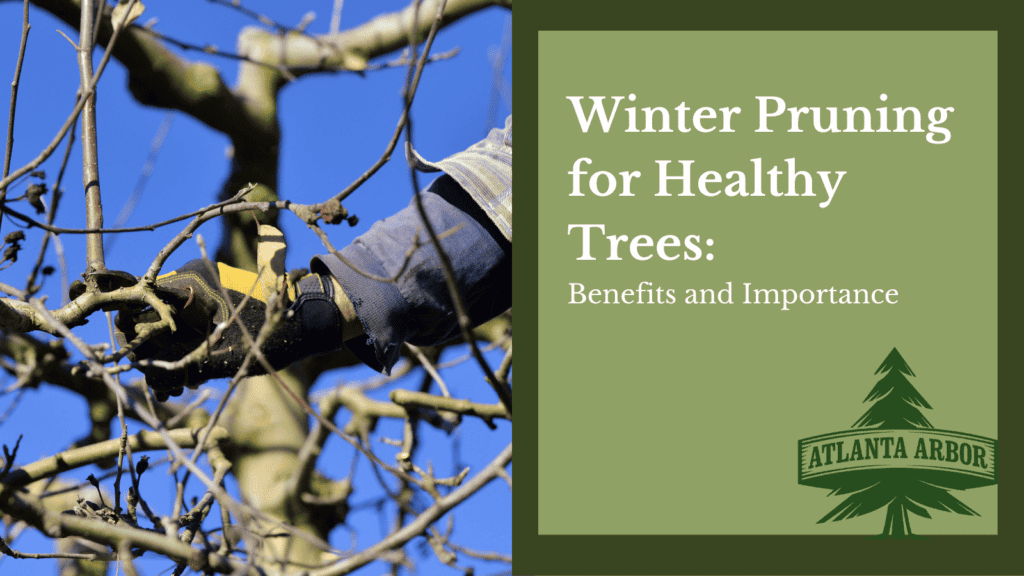As winter blankets the ground in a serene calm, trees enter a period of dormancy. While many may think it’s a time for hibernation, this season is an ideal opportunity for tree care enthusiasts to engage in the important practice of winter pruning. The leafless state of trees in winter makes it easier to identify and remove dying or diseased limbs. This practice is not only beneficial for the aesthetic appeal of trees but is also essential for their health and longevity.
The benefit of pruning during the dormant season is that it puts less stress on the trees, allowing for robust spring growth. Timely winter pruning can reduce the risks associated with winter weather, such as the damage from heavy snow and ice accumulation, and help in the control of pests and diseases.

What are the Benefits of Winter Pruning?
Winter pruning offers several key benefits for trees, contributing significantly to their health, aesthetics, and safety. Here are the primary advantages:
- Easier Identification of Problem Areas: During winter, trees lose their leaves, providing a clearer view of the tree’s structure. This bare state makes it easier to spot dead, diseased, or damaged branches that need removal. Effective identification and removal of these problematic limbs are crucial for the tree’s overall health.
- Reduced Stress on Trees: Pruning when trees are dormant in winter minimizes stress and stimulates vigorous growth in the spring. Since trees are not actively growing during the colder months, they won’t suffer as much from the loss of branches. This period of inactivity is the ideal time for pruning, as it allows trees to heal from the pruning cuts before the growing season starts.
- Disease Management: Many tree diseases are less active in the cold of winter. Pruning during this time can help prevent the spread of diseases that are more likely to infect trees during warmer, more active periods. By removing diseased branches in winter, you reduce the risk of disease spread in the upcoming growing season.
Why is it Important to Prune Trees in the Winter?
Winter pruning holds paramount importance in tree management for several reasons. This practice is not just about maintaining the tree’s appearance but also about maintaining its health, safety, and growth. Here’s why winter pruning is so crucial:
- Promoting Healthy Growth: Pruning in winter is essential for removing dead, diseased, or damaged branches. This process prevents the spread of diseases and pests and encourages healthier, more vigorous growth in the spring. By selectively removing certain parts of a tree, you direct the tree’s energy and resources towards producing strong, healthy new growth.
- Safety Considerations: Overgrown or dead branches can pose significant hazards, especially during winter when heavy snowfall or ice can cause them to break and fall. Winter pruning eliminates these potential dangers, safeguarding property and people. This proactive approach is especially important in urban or residential areas where falling branches could damage buildings, vehicles, or injure individuals.
- Improved Fruit Production: For fruit-bearing trees, winter pruning is critical for shaping the trees and thinning out the branches. This process allows better air circulation and sunlight penetration, which are vital for the quality and quantity of fruit production. It also helps in balancing fruit-bearing limbs, leading to a more consistent and abundant yield.
- Pest Management: By removing infested branches during winter, the risk of pests proliferating in the warmer months is significantly reduced. This proactive step is crucial in maintaining the overall health of the tree.

Why is Winter a Key Season for Spotting Problematic Tree Limbs?
During winter, trees shed their leaves, revealing their bare branches and making it much easier to spot limbs that may be in decline. This seasonal transformation is crucial for arborists and tree care enthusiasts, as it allows for a clear view of the tree’s structure, essential for a detailed assessment of its health. Without the dense foliage of other seasons, identifying potentially diseased, damaged, or structurally weak limbs becomes a more straightforward task.
The leafless state of trees in winter is not just a natural occurrence but a strategic opportunity for targeted pruning and care. Addressing these issues in the dormant season is vital for maintaining the tree’s health and structural integrity. By removing problematic branches during this time, risks are mitigated, and the tree is better prepared for robust growth in the spring, ensuring its longevity and safety.
Optimizing Tree Health with Winter Pruning: Minimizing Stress for Spring
Tree pruning plays a large role in reducing stress on trees during their dormant phase. In this season, trees naturally conserve energy and direct it towards vital functions like root development. Pruning at this time, therefore, becomes a less stressful process for the tree. The removal of unnecessary or problematic branches is achieved with minimal impact on the tree’s health. This strategic timing is not only beneficial for the tree’s wellbeing but also provides an opportunity to clear branches that may obstruct views from your home or encroach upon structures like roofs and driveways.
By eliminating excess and potentially unhealthy limbs, trees can allocate more resources to new growth and recovery. This focused energy distribution results in a more vigorous and resilient tree come spring. Regular winter pruning ensures that trees maintain not only their aesthetic appeal but also their structural integrity and health, ready to thrive in the warmer months ahead.
What Types of Trees Benefit Most from Winter Pruning?
Winter pruning is beneficial for a wide range of tree species, but some types particularly thrive when pruned during the dormant season. Here’s an overview:
- Deciduous Trees: Most deciduous trees, which shed their leaves in autumn, are ideal candidates for winter pruning. Winter allows a clear view of the tree structure, making it easier to identify and remove any diseased, damaged, or dead branches. Examples include oak, maple, ash, and elm trees. Pruning these trees in winter can encourage vigorous growth in the spring.
- Fruit Trees: Winter pruning is especially beneficial for fruit trees like apple, pear, and cherry. It helps to shape the tree, improve sunlight penetration and air circulation within the canopy, and stimulate the growth of new fruiting wood. It’s important to note that each fruit tree species may have specific pruning needs and times.
- Ornamental Trees: Many ornamental trees, which are grown for their aesthetic appeal, also benefit from winter pruning. It helps in maintaining their shape and promoting healthy growth. Examples include crabapple and crape myrtle.
However, it’s important to recognize that not all trees should be pruned in winter. For example:
- Spring-Blooming Trees: Trees that flower in early spring, like magnolias and lilacs, should ideally be pruned immediately after they bloom. Pruning these trees in winter could remove the upcoming spring’s flower buds.
- Certain Tropical or Subtropical Trees: These trees might be better pruned in late winter or early spring, closer to their active growing season, depending on the specific climate and conditions.
It’s always advisable to research or consult with a local arborist about the specific pruning needs of different tree species in your area. Each species may have unique requirements based on its growth patterns, health, and local climate conditions.

What Are the Best Techniques for Winter Pruning?
When undertaking winter pruning, it’s important to use effective techniques and the right tools to ensure the health and proper growth of your trees. Key practices include:
- Select Appropriate Tools: Use sharp, clean pruners, loppers, and saws for clean cuts.
- Correct Pruning Cuts: Make cuts close to the branch collar without damaging it. For large branches, use the three-cut method to prevent bark tearing.
- Focus on Problematic Branches: Prioritize removing dead, diseased, or damaged branches to maintain tree health and structure.
- Thinning Over Topping: Thin out select branches to improve light and air flow, avoiding the harmful practice of topping.
- Maintain Tree Balance: Aim for a natural shape and avoid over-pruning; typically, no more than 15-20% of the crown should be removed.
- Age and Species Considerations: Tailor your approach based on the tree’s age and species.
- Safety: For high or complex jobs, consider hiring a professional arborist.
By embracing the practice of winter pruning, gardeners and arborists can ensure that their trees are not only aesthetically pleasing but also strong, healthy, and well-prepared for the year ahead.
How Does Winter Pruning Reduce The Risk of Pests?
Winter pruning is an effective strategy in reducing the risk of pest infestations in trees. During the colder months, many pests are dormant, making this the ideal time to prune without attracting insects to fresh cuts. This is because new wounds on trees during the active growing seasons can be inviting to various pests, leading to infestations that can harm the tree’s health. By pruning in winter, when insect activity is at a minimum, the risk of attracting these pests is significantly reduced.
Additionally, winter pruning helps in removing parts of the tree that might already be infested or more susceptible to future infestations. Diseased or weak limbs can be prime targets for pests. By eliminating these potential breeding grounds, the overall health of the tree is preserved, making it more resilient against pest attacks in the spring and summer. This proactive approach not only helps in maintaining the tree’s health but also contributes to a balanced ecosystem in your garden or landscape.
Can winter pruning prevent future tree problems or are annual tree inspections still necessary?
Engaging in winter pruning can preemptively address potential issues, reducing future risks to the tree and its surroundings. By removing weak, damaged, or diseased limbs, you prevent the likelihood of branches falling and causing damage or injury. This proactive approach also curtails the development of structural problems, ensuring the tree grows more resiliently. Additionally, pruning helps maintain the tree’s desired shape and size, making it less susceptible to damage from storms or heavy snowfall, ultimately preserving both the tree’s health and the safety of the environment around it.
Incorporating winter pruning as a part of your annual tree inspection routine is essential for identifying and addressing potential arboreal health issues before they escalate. This inspection-pruning cycle allows for a comprehensive assessment of the tree’s condition, highlighting areas that require immediate attention and ensuring timely intervention. By scheduling annual inspections, preferably in winter, you can spot and rectify structural weaknesses, signs of decay, and pest infestations early on. This symbiotic relationship between inspection and pruning ensures trees remain vibrant and structurally sound throughout the year.
How does winter pruning affect tree health?
Winter pruning plays a pivotal role in enhancing tree health by strategically removing branches that could detract from the tree’s vitality. This selective removal helps prevent the spread of diseases and pests, which are less active in winter, thereby protecting the tree during its most vulnerable periods. By eliminating competition for resources among branches, the remaining parts of the tree receive more nutrients and light, encouraging the development of a stronger, more robust structure. This careful management during dormancy supports the tree’s recovery and growth, leading to a healthier life cycle.
What Companies Help With Tree Trimming and Pruning In the Winter?
Atlanta Arbor offers tree trimming and pruning in Atlanta all year round. With over 10 years of experience and certified arborists on staff, Atlanta ARbor can help with tree service needs during the cold months of the year.
